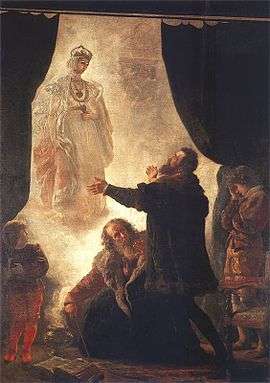Weiße Frauen

In German folklore, the Weiße Frauen (meaning White Women) are elven-like spirits that may have derived from Germanic paganism in the form of legends of light elves (Old Norse: Ljósálfar). The Dutch Witte Wieven went at least as far back as the 7th century, and their mistranslation as White Women instead of the original Wise Women can be explained by the Dutch word wit also meaning white. They are described as beautiful and enchanted creatures who appear at noon and can be seen sitting in the sunshine brushing their hair or bathing in a brook. They may be guarding treasure or haunting castles. They entreat mortals to break their spell, but this is always unsuccessful. The mythology dates back at least to the Middle Ages and was known in the present-day area of Germany.
Origins
Weiße Frauen literally means "white ladies" in German. The association with the color white and their appearance in sunlight is thought by Jacob Grimm[1] to stem from the original Old Norse and Teutonic mythology of alven (elves), specifically the bright Ljósálfar. These "light elves" lived in Álfheim (part of heaven) under the fertility god Freyr.[2] As mythology evolved, elves no longer lived in Álfheim but lived on earth in nature. The White Women also may represent ancient beliefs in ancestral spirits or older native goddesses and nature spirits. Jacob Grimm noted in particular they might come from Holda, "Berhta, white by her very name"[3] and Ostara. According to Grimm's Teutonic Mythology[1] and to the Mythology of All Races Series, the enchantment under which they suffer "may be a symbol of the ban laid by Christianity on the divinities of the older faith."[4] Similar in name to the Witte Wieven of Dutch mythology, the Weisse Frauen may have come from the Germanic belief in disen or land wights and alven.[5]
Related beings
Grimm notes the image of the Weiße Frauen basking in the sun and bathing "melts into the notion of a water-holde [i.e. Holda] and nixe".[1] The Weiße Frauen also have counterparts in both name and characterization in neighboring countries: In the Netherlands known as the Witte Wieven, and in France known as the Dames Blanches.
There are also many legends in German folklore regarding "Weiße Frauen", which are actually equivalent to the legends of White Ladies; ghosts of the United Kingdom.
Notes
- 1 2 3 Grimm 1835, Chapter 32, pp 2-3.
- ↑ Bellows, p. 89; Crossley-Holland, pp. xx, 61.
- ↑ Behrta as defined by Grimm, is more commonly known as Perchta or Berchta, per his description Chapter 31 p. 4
- ↑ Marshall Jones Company 1930:221-222, citing in footnote "Grimm [a] 962f" (Grimm's Teutonic Mythology).
- ↑ Reginheim 2002.
Sources
- Bellows, Henry Adams. Grimnismol. The Poetic Edda (Princeton: Princeton UP, 1936), pp. 85–107.
- Crossley-Holland, Kevin. The Norse Myths. New York: Pantheon, 1980.
- Grimm, Jacob (1835). Deutsche Mythologie (German Mythology); From English released version Grimm's Teutonic Mythology (1888); Available online by Northvegr © 2004-2007, Chapter 32, pages 2-3.
- Marshall Jones Company (1930). Mythology of all Races Series, Volume 2 Eddic, Great Britain: Marshall Jones Company, 1930, pp. 221–222.
- Reginheim. Witte wieven. 2002. (in English) File retrieved 03-08-2007.